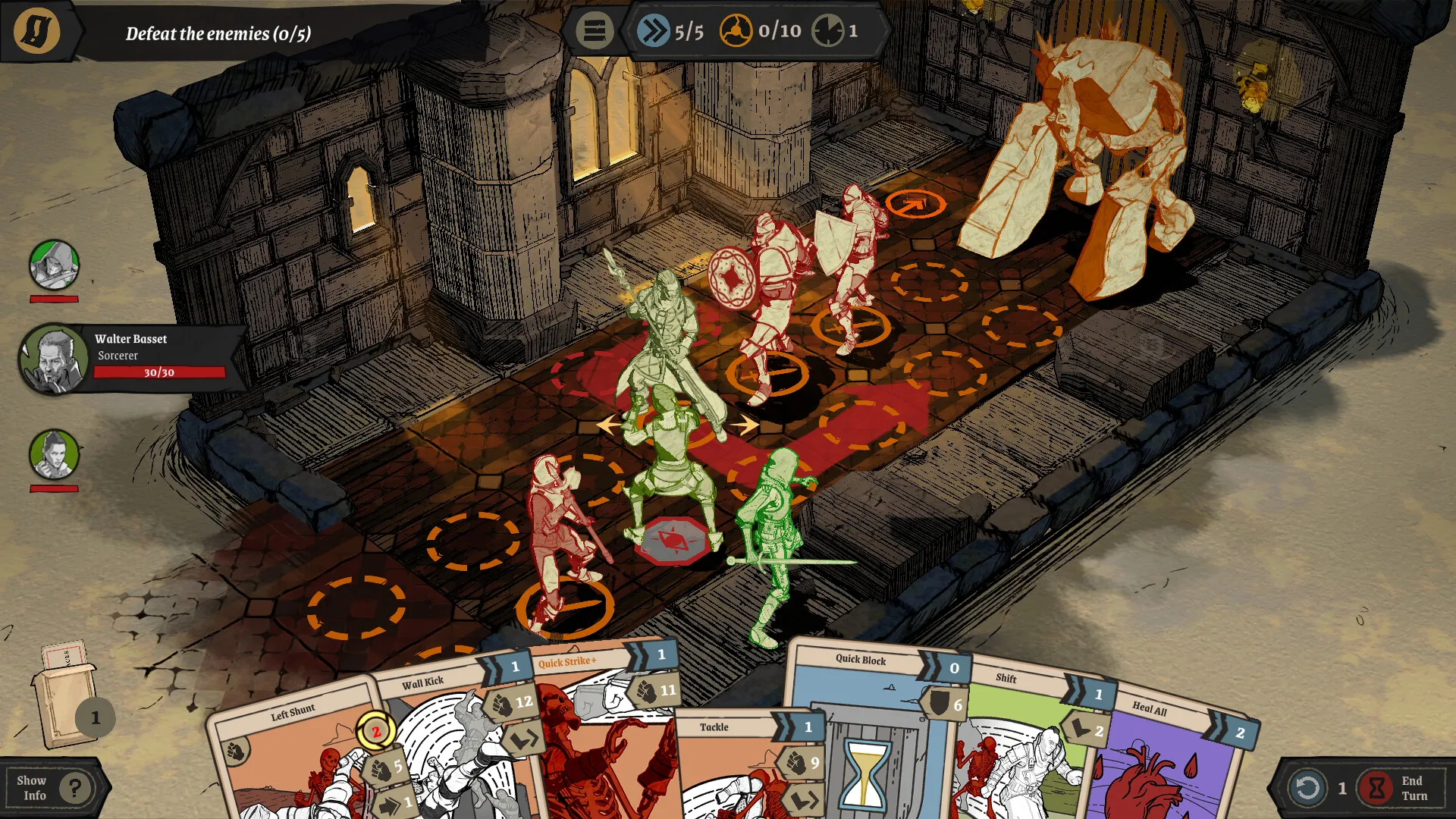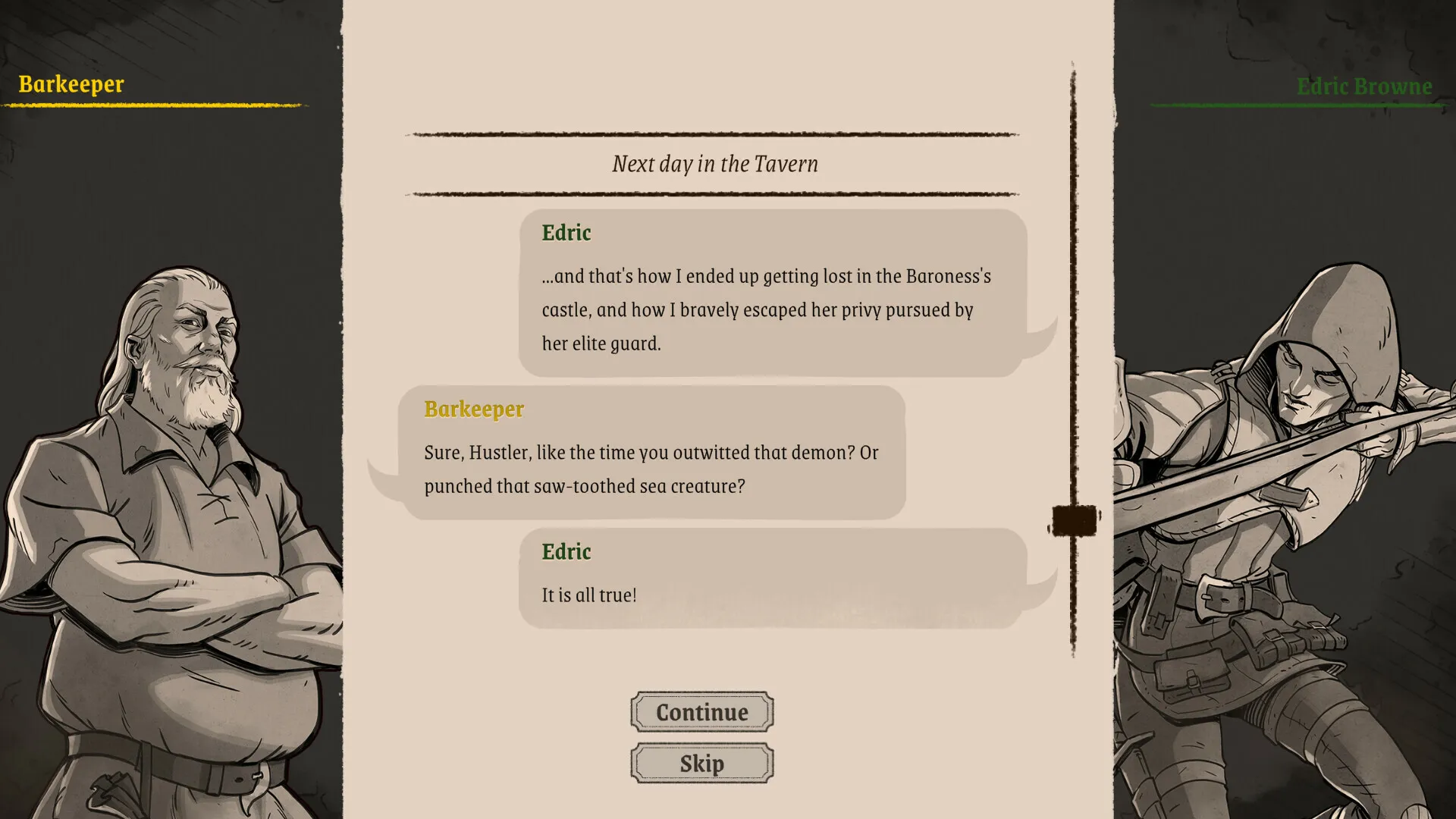Knights in Tight Spaces transforms a modern action formula into a setting steeped in medieval lore. The game places its tactical encounters on compact, gridded maps that evoke intimate battlegrounds, where each move carries weight. Here, strategy is rendered through card play that directs both movement and combat—a system that asks players to think several moves ahead.
At the heart of the game is a premise that invites the player into a kingdom marked by peril and hidden plots. Its narrative unfolds in a world filled with knights, mages, and rogues, each character defined by a set of abilities that reflect a diverse heritage of fighting styles.
This design nod appears to be influenced by varied cultural traditions, mixing classic fantasy motifs with modern strategic challenges. The card mechanics, reminiscent of time-honored tabletop experiences, create a platform where narrative moments and tactical decisions align, sometimes creating a sense of harmony and at other times a striking contrast.
This title attracts enthusiasts of strategy-based card encounters, precise tactical planning, and immersive role-play. Its approach to combining storyline and mechanics brings a layer of intellectual interest, prompting comparisons with international storytelling in cinema and other forms of visual media. The game invites reflection on how historical art and modern design can converse in surprising ways.
Mechanics of Conflict: Card Tactics and Tactical Environments
The card-based combat system shapes every encounter in Knights in Tight Spaces, assigning each card a distinct role in battle. Cards serve as commands that instruct characters to strike foes, reposition on the board, block attacks, or perform specialized moves that disrupt enemy formations.
Some cards trigger straightforward damage, while others enable repositioning maneuvers or manipulate adversaries into unfavorable positions. This system creates a scenario where each card becomes a tool for both offense and defense, inviting players to construct strategies that reflect a wide spectrum of tactical influences drawn from various cultural approaches to game design.
Momentum functions as a finite resource that determines how many cards can be played each round. Players allocate momentum with care, balancing aggressive actions against the need to secure a safe stance. This resource management adds a strategic layer that reminds one of combat scenarios found in international cinematic depictions of tactical warfare, where each decision carries a weight of its own.
The interplay between card selection and momentum conservation invites a careful calculation akin to chess, with each move echoing influences from diverse martial traditions.
The battle arenas themselves are presented as confined, grid-based spaces that demand a sharp sense of spatial awareness. The limited space compels players to think critically about positioning and the sequence of moves.
Environmental elements such as walls, narrow corridors, and obstacles are not merely static backdrops; they influence the flow of combat by creating opportunities for counterattacks or triggering chain reactions. For example, a well-timed card may push an enemy into a corner or against a barrier, leading to a cascading series of reactions reminiscent of strategic layouts found in international tactical simulations.
Team coordination is integral to the game’s approach to combat. Party members provide automatic support when enemies fall within their range, creating a cascade of synchronized actions.
Players must account for the placement of every character, as misalignment can result in compounded damage or the irreversible loss of a fighter. The combat dynamics stress a constant trade-off between taking risks for high-reward outcomes and prioritizing defensive positioning, a balance that is reflective of competing traditions in game design across different cultures.
Enemy behavior introduces further complexity. Opponents announce their intended moves ahead of time, requiring players to forecast and adjust their plans. Some foes display reactive traits such as counterattacks or shifts in movement that force a reconsideration of established tactics.
The increasing difficulty over the course of a run challenges the player to adapt continuously, creating an engaging pattern of escalating threats that mirrors the global conversation on strategic innovation in interactive entertainment.
Classes and Companions: A Cross-Cultural Study
Knights in Tight Spaces invites players to engage with character classes that carry echoes of diverse cultural storytelling traditions. The game presents core roles such as the Brawler, Rogue, and Sorcerer, each with a distinct combat style.
The Brawler delivers straightforward physical power; the Rogue emphasizes swift maneuvers and subtle strikes; the Sorcerer channels energy through calculated magic. Each class starts with a tailored set of cards that define their abilities, influencing how players approach tactical battles on confined grids.
As progress unfolds, more specialized roles emerge, reflecting a legacy of character development found in literature and cinema worldwide. These advanced classes expand the available strategies, offering fresh viewpoints on conflict that mirror a range of cultural expressions.
The introduction of these roles illustrates how modern interactive works adopt and reinterpret age-old archetypes, inviting players to experience a fusion of global influences in combat strategy.
The process of assembling a team takes place in a setting reminiscent of traditional gathering spots, where additional heroes join the fray. Every new recruit brings extra momentum and a set of cards that can shift the dynamics of the shared deck.
This collective resource demands careful planning and cooperation among characters, emphasizing the interplay between individual skills and team performance. The careful balancing of shared energy and card choices calls for strategies that respect both individual contribution and collective efficiency.
Choices in gear further refine each character’s capabilities. Weapons, armor, and other items modify statistics and introduce effects such as damage boosts or protective measures.
Players face decisions in integrating these upgrades into their deck, weighing potential benefits against the challenges of coordinating a larger team. This fusion of character design and party dynamics prompts reflection on how global artistic traditions and local gaming practices converge in interactive storytelling.
Narrative and Role-Play: A Cultural Mirror
In Knights in Tight Spaces, the story does not reside in a separate narrative but intertwines with each tactical encounter. The plot unfolds in a kingdom filled with political intrigues and personal quests, where every battle contributes to the unfolding drama.
As players progress through each challenge, they experience moments where the unfolding narrative influences combat choices, offering rewards and paths that echo the decision-making found in classic interactive fiction. Branching dialogue injects a sense of agency reminiscent of traditional oral storytelling, inviting players to select conversational responses that unlock varied rewards and unexpected side missions.
The game portrays a central hero whose distinct personality traits reflect a rich cultural heritage, enhanced by lively exchanges with a diverse party of companions. Their banter reveals underlying histories and personal ambitions that add a layer of depth to the central narrative.
Optional quests and incidental encounters enrich the game world, creating a layered environment that mirrors the narrative techniques of international cinema.
These narrative nuances speak to regional storytelling traditions while engaging a worldwide audience, prompting reflections on identity, cultural exchange, and the evolution of storytelling in modern interactive media. The experience leaves room for continued contemplation about how digital narratives shape our perceptions of tradition and modernity.
Visuals, Audio, and Art Style: A Global Lens
Knights in Tight Spaces presents artwork that recalls hand-drawn illustrations on ancient papyrus. The design shifts from stark tones to a warmer, detailed fantasy palette reminiscent of classical Eastern and European art traditions. Heroes, adversaries, and backdrops exhibit distinct characteristics that draw on medieval aesthetics and lend a rich visual context to the gameplay.
The animations for combat deliver a kinetic experience. Each attack, movement, or environmental interaction unfolds with smooth precision, creating moments where enemies are seen being physically displaced in ways that echo the dramatic staging of international action cinema.
The user interface, with its clear grid layout and efficient card management system, supports strategic choices without distracting from the core experience. Nonetheless, the reliance on specific color cues may present challenges for some players.
Musically, the score pairs orchestral elements with modern rhythmic influences, forming an auditory experience that clearly signals enemy actions and critical moves. The ambient sounds further enrich the in-game environment, drawing comparisons to sound design in global film traditions. These audiovisual elements collectively highlight the game’s ability to serve as a meeting point for diverse artistic practices and cultural histories.
Grid-Based Realms and Endless Challenges
The game features battle arenas defined by compact, grid-like layouts that demand precision and forward planning. Environments range from elevated castle ramparts to cozy tavern backrooms, each designed to compel strategic positioning and careful movement. Terrain features serve as both obstacles and tools, forcing players and opponents alike to adapt their tactics.
Progression follows a structured campaign where familiar narrative beats set the stage, yet encounters remain fresh through randomization. Players face a consistent tension between predictable story segments and spontaneous, dynamic battles.
Each run carries significant risk, with the possibility of losing progress and resetting the deck adding gravity to every decision. The game’s design encourages multiple playthroughs, enhanced by daily challenges and endless modes that extend its life.
This approach invites players from various cultural backgrounds to experience the thrill of constant reinvention in a realm that tests both their tactical acumen and creative problem-solving skills.
The Review
Knights in Tight Spaces
Knights in Tight Spaces offers an engaging tactical challenge enriched by cultural storytelling and dynamic visuals. Its blend of strategic grid combat, evolving narrative, and replayable encounters rewards careful planning and creative risk-taking. Despite occasional pacing issues and accessibility concerns, it stands as a commendable addition to the roguelike card-battler genre.
PROS
- Captivating narrative elements intertwined with gameplay
- High replay value with dynamic encounters
- Rich, hand-drawn visuals and detailed character designs
CONS
- Dependence on tactical positioning can lead to frustrating setbacks
- Occasional pacing issues




















































